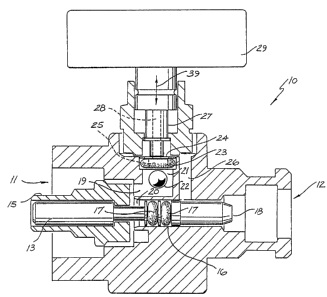Note: Descriptions are shown in the official language in which they were submitted.
1 3 ~
62616-105
Background of the Inven~ion
The present invention relates to fluid flow shut-off
devices and in particular to an emergency, automatic shut-off
device for gas cylinder operation.
Discussion of Prior Art
An automatic fluid flow shut-off device is known in
which a ball moves into engagement with a seat to prevent gas flow
in emergencies. However, it can not be guaranteed that the device
will operate in all circumstances, particularly if the device is
incorrectly oriented relative to the horizontal.
German Specification 2249598 describes a ball valve
which is operated if the gas flow becomes excessive. The valve is
intended to be operated so that the valve is accelerated upwardly
against the force of gravity when the gas flow becomes excessive.
There is no consideration given to providing this valve with a
shut-off function if it becomes incorrectly oriented. Still
further, the various embodiments of this particular device shown
and dlscussed, do not lend themselves to actuation if the device
is merely tilted.
Objects and Summary of the Invention
It is the object of the present invention to overcome or
substantially ameliorate the above disadvantage.
There is disclosed herein a fluid flow shut-off device
comprising:
a hollow body having an inlet connection portion to be
connected to a supply of fluid under pressure, and an outlet
connection portion to be connected to an apparatus to receive said
fluid, said body providing a chamber through which the fluid
passes from a chamber inlet to a chamber outlet, said inlet and
outlet being positioned so that fluid entering said chamber enters
in a direction having a direction component normal to the
, 1
~ 3~ ~7 ~ ~
-- 2 --
direction of the fluid entering said outlet, w~th said outlet being
positioned at an upper portion of said chamber whell said device is in its
norma7 operating orientation having said inlet generally horizontally
fac~ng;
a movable valve ball captively located within said chamber to
selectively engage said outlet to prevent fluid flow therethrough, wherein
said ball will engage said outlet when either the fluid flow rate becomes
excessively high through said device or said device is tilted through a
predetermined angle from its normal operating orientation.
Brief Description of the Drawing
A preferred form of the present invention will now be described by
way of example with reference to the accompanying drawing, which
schematically depicts in sectioned side elevation a fluid flow shut-off
device.
Description of the Preferred Embodiment
In the accompanying drawing there is schematically depicted a fluid
flow shut-off device 10. The device 10 is connectable to a gas cylinder
(not shown) at the inlet end 11. The connection being any convenient means
such as snap-on, push-on or screw threaded, connection. At its other end,
outlet end 12 is adapted to be connected to a regulator (not shown).
The device 10 has a shaft 13 located in a body 15 adapted to abut a
needle valve of the gas cylinder.
The body 15 has a further passage 16 sealingly engaged by O-rings 17
mounted on the shaft 13. The shaft 13 extends to a leading portion 18.
When connected to the regulator, the leading portion 18 is engaged and the
shaft 13 moved to operate the needle valve of the gas cylinder. The O-rings
17 divide the passage 16 into an upstream and a downstream position.
The passage 15 communicates with a chamber 19 having an inlet chamber
portion 20 and an outlet chamber portion 21. Located in the outlet chamber
~ ~ 3 5 ~ 7 ~
portion 21 is a ball 22. The chamber portion 21 is of a cylindrical
configuration, having its axis normal to the axis of the passage 16.
The chamber portion 21 is provided with an 0-ring 23 against which a
washer 24 bears. The 0-ring 23 and washer 24 provide an outlet passage 25.
The outlet passage 25 is of a smaller cross sectional area than the ball
22, so that upon the ball 22 seating against the 0-ring 23, fluid flow is
prevented.
Fluid leaving the passage 24 passes through the washer 24 via the
passage 25 to an outlet passage 26 to be delivered to the outlet end 12.
It should be appreciated that fluid entering the chamber 21, from the
chamber 20, has a direction of travel at least partly normal to the
direction of travel of fluid entering the passage 25. By providing this
configuration, the device 10, if inadvertently tilted or moved, independent
of the starting orientation, will act to stop gas flow by engagement of the
ball 22 with the 0-ring 23. This will also occur when there is excessively
high gas speeds.
Also mounted in the body 15 is a hollow shaft 27 having a central
passage 28 extending to the passage 25. The passage 28 communicates with a
pressure gauge 29. Still further, the shaft 27 is movable in the direction
of the arrow 39 so that movement of the shaft 27 can move the ball 22 from
engagement with the 0-ring 23 in order to reset the devlce 10.
~ here a steel ball 22 is employed, it has been found that the ratio
of the ball diameter to the diameter of the chamber 21 is.approximately .7.
It has also been found that the ball 22 if provided with a weight of
about 4.3 gm (about 4.8 mm diameter) co-operates with a chamber 21 diameter
of 6.60 mm. As a further alternative, a ball 22 having a weight of 4.871
gm (5.40 mm diameter) co-operates with a chamber 21 diameter of 7.50 mm.
~s
